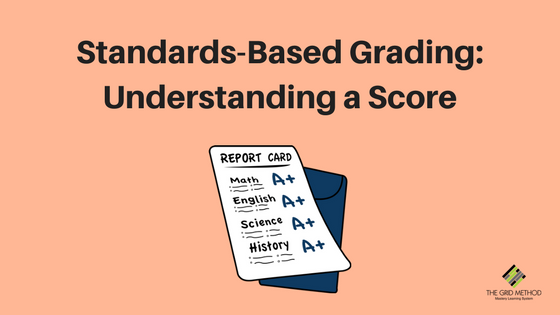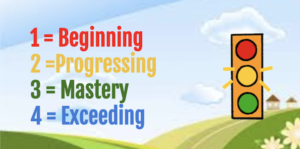As educators and administrators explore standards-based grading, it’s important for all parties to understand what a score in the classroom truly means.
There is a number of standards-based grading experts who write full books on what a score within a standards-based grading system actually means. However, in this blog we’ll be focusing on the basics of a score’s meaning and possibly the most important element of all discussions: how to explain it to your students and stakeholders.
The Basics
Most standards-based grading scales utilize a 4 tiered system. Each numeric value is connected to a vocabulary term describing the student’s level of understanding :
1 = Beginning Understanding
2 = Progressing Understanding
3 = Mastery Understanding
4 = Exceeding Understanding Beyond the Standard
The numeric values do not directly correlate to a percentage as a traditional score of an A, B, C, D, or F would. Rather, it is a shift in understanding toward what a score communicates to the student. This idea allows you to provide effective feedback to your students, focused around what the student understands about the content.
Make it Make Sense
Often, one of the most frustrating elements of standards-based grading is communicating the shift in grading to students and other stakeholders. Typically, a parent has grown up with a percentage based grading scale. Therefore, explaining the need for the shift in grading philosophy often results in a “I learned it using percentages and I turned out fine.” response.
However, you know better! Change is necessary to continue to develop innovative, 21st century thinkers! By providing students opportunities to receive individualized feedback, we continue to build strong, self-aware leaders for our future communities.
Strategy #1 : Connect colors to Students’ Level of Understanding:
In the example below, numerical values are not just connected to vocabulary, but colors similar to a stop light. This allows students to have multiple indicators to show a students success.
Earning a score of a RED (1) indicates the student needs to STOP and get more support!
Earning a score of a YELLOW (2) indicates the student needs to Slow Down & proceed with Caution. More support may be needed as the student continues, as they may find a pothole ahead!
Earning a score of a GREEN (3) indicates the student is Good to Go! Keep it up!
Earning a score of a BLUE (4) indicates the student is soaring through the clouds and exceeding the standards requirements!
[scroll down to keep reading]Strategy #2 : Opportunities to Practice
Practice makes perfect! Utilize practice worksheets to provide students opportunities to practice the new standards-based grading scale. The Trick? Start Small! Begin with a “target” students are far beyond – like coloring in the lines.
When focusing on a target students can easily meet, you can ask them to focus on the imitation of the score, rather then a challenging standard.
Next, work toward a more difficult target. This process builds a strong base for your students’ level of understanding, scaffolding their standards-based grading knowledge toward what a score means in your classroom.
Within each target, ask students to describe their work and foster discussion around what a score means. This will not only benefit your students’ ownership of the system, but also their ability to explain the process to other stakeholders.
Finish it off, by sending a few clean worksheets home for parents to work on with their student – transferring classroom instruction to educating the community.
Continue your exploration with more Standards-Based Grading posts!
- Standards-Based Grading : The Basics
- Standards-Based Grading : 4 Pillars
- Standards-Based Grading : Combating Common Concerns
- Standards-Based Grading : Reporting
- Standards-Based Grading : First Steps (video)
- Standards-Based Grading : Parent Communication (Coming Soon!)








